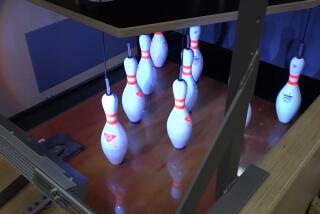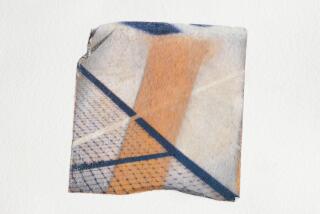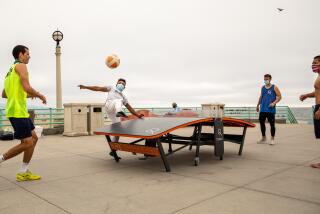On the Rebound : Croquet--a New Breed of Competitors
WINDSOR, Calif. — Debbie Prentis of Florida’s posh Palm Beach Polo and Country Club took a nervous drag on a cigarette and eyed her opponent warily.
Reid Marshall lumbered by with a heavy wooden mallet in hand. He chewed hard on his lip. There was blood in the husky Canadian’s mouth.
Through two matches and more than three hours, the two stalked each other under a merciless September sun--playing croquet. Not the tame backyard game, mind you, this was championship croquet. And Marshall and Prentis were vying for the U.S. national title, the competition being held for the first time in 100 years outside of New York.
Image Problem
“Visions of little wire wickets and rubber mallets at your aunt’s house is a very difficult image to change,” lamented Jack Osborn, president of the U.S. Croquet Assn. “But championship croquet is a sport with tremendous torque and tension. Psychologically it is a very tough game.”
Osborn has almost single-handedly brought about the revival of organized croquet in this country. The U.S. Croquet Assn., which he founded in 1977 with five clubs and 100 members, now boasts 250 clubs and more than 3,000 registered players.
But the sport’s increasing popularity has also led to some proletariat thinning of this once exclusively blue-blooded pastime and created a curious East-West cultural tension.
“Westerners have an inherent distrust of anything Eastern,” Osborn said. “One of the reasons we came to California this year was hopefully to defuse that polarization. You don’t have to be rich and from Palm Beach to play.”
For the last nine years the nationals have been held in New York City’s Central Park. “You had to walk the park with your mallet up in the air just to get through intact,” said Tom Lufkin, president of the San Francisco Croquet Club.
But Prentis and Marshall’s cat-and-mouse drama unfolded Sept. 21 on the safe and immaculate lawns of the Sonoma-Cutrer Vineyard, an 800-acre estate set in rolling wine country 60 miles north of San Francisco.
Smooth Surfaces
One player, looking over the two courts--as smooth as putting greens--put in at a cost of $150,000, remarked, “It’s hard to believe they are grass.”
Winery proprietor Brice Jones said he wondered several years ago what to do with some of his extra land. “I thought about polo fields,” he said. “But that was too damned expensive. Croquet seemed simple. It wasn’t.”
At the top level, croquet is far from simple. The game requires the strategic acumen of chess and the physical finesse of golf. Women and men compete as equals in tournament play.
The object is to maneuver two balls clockwise and back again through a course of six iron wickets and a stake before the other side does. It sounds easy, but it isn’t. For one thing, the wickets, weighing a hefty six pounds each, allow only an eighth of an inch clearance for the balls to pass through.
And in tournament play, complex split shots, jumps and combination strikes are used in an elaborate game of offensive and defensive positioning. Players are constantly thinking several shots ahead. It is a war of strategy and nerves.
Banned in Boston
The sport was banned in Boston in the late 1800s because, the city said, it was “calculated to bring out all the evil passions of humanity.”
John Osborn, son of the U.S. Croquet Assn.’s president and currently the No.1-ranked player in the country, broke a mallet over his knee at a Phoenix match earlier this year. “I’ve broken a few mallets,” he confessed, “some in anger, some by accident.”
Croquet probably developed out of a French peasant’s game during the reign of Louis XIV. The word originally meant “crooked stick,” Jack Osborn said. A more genteel version flourished for a while in Victorian England and then fell out of vogue as tennis became the new rage.
In the 1920s the New York literary and social set picked up the sport. These people were serious players. Former Ambassador W. Averell Harriman, who along with critic Alexander Woollcott, playwright George S. Kaufman and actor Harpo Marx is a member of the U.S. Croquet Assn. Hall of Fame, is said to have once hired a tractor to clear his court when a game was interrupted by a sudden snowstorm. Marx reportedly stored his croquet equipment in a special refrigerated room.
Celebrity Players
Hollywood also took to the craze. According to Tom Lufkin, who was introduced to the sport by Samuel Goldwyn in the 1950s, the movie mogul had a sand-trapped court constructed on his Beverly Hills estate. Humphrey Bogart and Darryl Zanuck, who was called the “Terrible-Tempered Mr. Bang,” often joined in Goldwyn’s matches.
Outside of a few private clubs, croquet over the ensuing decades mostly languished in its bastardized backyard version--until Jack Osborn founded the U.S. Croquet Assn. in the 1970s.
But despite a remarkable growth that has attracted an increasingly diverse group of players, the association retains a certain . . . well, toniness. Croquet cachet.
Regulation whites--sneakers, knee socks, shorts and polo shirts--are de rigeur attire for championship play. Tournament dinner parties call for black tie and tennis shoes.
“This was the first year it wasn’t tie and tennies,” Jack Osborn said of the formal Hall of Fame dinner held during the nationals, “in deference to the Western spirit of more casual living. It’s one thing to do it in New York.”
Brice Jones said he threw a deliciously untraditional party the night before the finals. “I got a country-western band,” he said with a grin. “Usually they have harps and flutes. Pandemonium broke loose.”
Talk of Rebellion
A Western rebellion of sorts is now rumbling in the sagebrush states. There is ungenteel talk among some Arizona players of forming another croquet league, to follow international rules, which have no time limitation. The American version uses a 45-second shot clock and matches conclude after 90 minutes.
All but one of these mutinous players were conspicuously absent from this year’s nationals. “Their absence is not accidental,” one tournament organizer confided.
“There’s a lot of dissatisfaction with the USCA leadership,” said Ray Bell, a Phoenix contractor and last year’s national singles champion. He sees himself as liaison between the warring factions. “There is room for both games,” he said.
“I like most of those guys,” Jack Osborn said. “They’re just misguided. There will be dissidents in anything.”
He said he has sat through international matches that took six hours. “It’s like watching a chess person think,” he said. “That’s not sport. There’s no torque. It’s a pathetically tedious game.”
Time Runs Out
Meanwhile, Debbie Prentis was in trouble. As the first of their two final matches for the national singles title wound down, Prentis was in a desperate run trying to overtake Reid Marshall’s lead. Her ball stuck in a wicket and time ran out.
She flopped on the grass under a powder blue awning and sulked. “I choked,” she said. The first woman ever to reach the finals, she was on the verge of making history. “If I do that again, I’m going to throw myself on the peg,” she declared.
Marshall, the intense young machinist from Vancouver, just chewed his lip. A couple of hours later, it was over. The Western upstart, playing in his first national tournament, won handily, 20 to 14.
More to Read
Go beyond the scoreboard
Get the latest on L.A.'s teams in the daily Sports Report newsletter.
You may occasionally receive promotional content from the Los Angeles Times.










